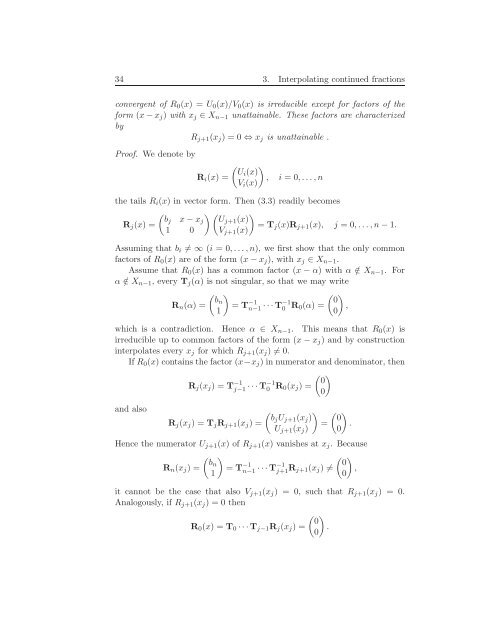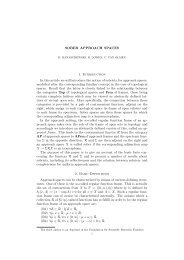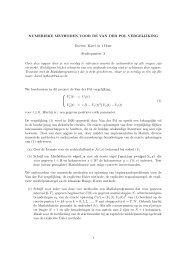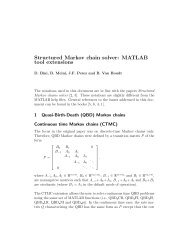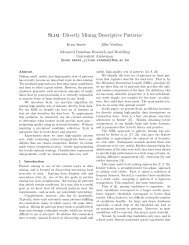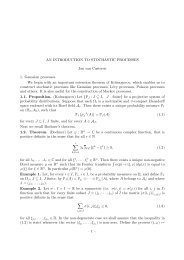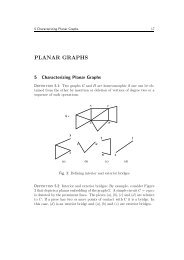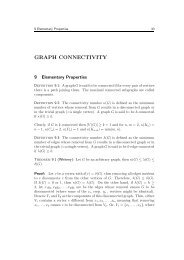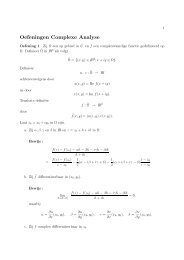Practical Rational Interpolation of Exact and Inexact Data Theory ...
Practical Rational Interpolation of Exact and Inexact Data Theory ...
Practical Rational Interpolation of Exact and Inexact Data Theory ...
Create successful ePaper yourself
Turn your PDF publications into a flip-book with our unique Google optimized e-Paper software.
34 3. Interpolating continued fractions<br />
convergent <strong>of</strong> R0(x) = U0(x)/V0(x) is irreducible except for factors <strong>of</strong> the<br />
form (x − xj) with xj ∈ Xn−1 unattainable. These factors are characterized<br />
by<br />
Rj+1(xj) = 0 ⇔ xj is unattainable .<br />
Pro<strong>of</strong>. We denote by<br />
Ri(x) =<br />
<br />
Ui(x)<br />
, i = 0,... ,n<br />
Vi(x)<br />
the tails Ri(x) in vector form. Then (3.3) readily becomes<br />
<br />
bj<br />
Rj(x) =<br />
1<br />
<br />
x − xj Uj+1(x)<br />
= Tj(x)Rj+1(x),<br />
0 Vj+1(x)<br />
j = 0,... ,n − 1.<br />
Assuming that bi = ∞ (i = 0,... ,n), we first show that the only common<br />
factors <strong>of</strong> R0(x) are <strong>of</strong> the form (x − xj), with xj ∈ Xn−1.<br />
Assume that R0(x) has a common factor (x − α) with α /∈ Xn−1. For<br />
α /∈ Xn−1, every Tj(α) is not singular, so that we may write<br />
Rn(α) =<br />
bn<br />
1<br />
<br />
= T −1<br />
n−1 · · ·T−1 0 R0(α) =<br />
which is a contradiction. Hence α ∈ Xn−1. This means that R0(x) is<br />
irreducible up to common factors <strong>of</strong> the form (x − xj) <strong>and</strong> by construction<br />
interpolates every xj for which Rj+1(xj) = 0.<br />
If R0(x) contains the factor (x−xj) in numerator <strong>and</strong> denominator, then<br />
<strong>and</strong> also<br />
Rj(xj) = T −1<br />
j−1 · · ·T−1 0 R0(xj) =<br />
Rj(xj) = TjRj+1(xj) =<br />
0<br />
0<br />
0<br />
0<br />
<br />
<br />
bjUj+1(xj)<br />
=<br />
Uj+1(xj)<br />
<br />
,<br />
<br />
0<br />
.<br />
0<br />
Hence the numerator Uj+1(x) <strong>of</strong> Rj+1(x) vanishes at xj. Because<br />
<br />
bn<br />
Rn(xj) = = T<br />
1<br />
−1<br />
n−1 · · ·T−1<br />
j+1Rj+1(xj) <br />
0<br />
= ,<br />
0<br />
it cannot be the case that also Vj+1(xj) = 0, such that Rj+1(xj) = 0.<br />
Analogously, if Rj+1(xj) = 0 then<br />
R0(x) = T0 · · ·Tj−1Rj(xj) =<br />
<br />
0<br />
.<br />
0


